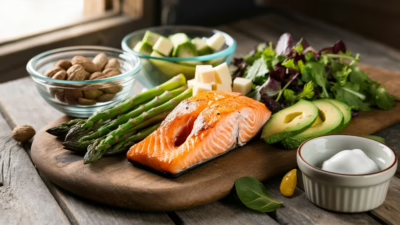When you’re ready to transition out of keto, you’ll need a strategic approach to prevent weight regain and minimize side effects. Start by gradually increasing your carbs by about 10 grams per week, focusing on nutrient-dense sources like sweet potatoes, quinoa, and legumes. You’ll want to maintain your protein intake while tracking your body’s response to the changes. Stay hydrated, support your digestive system with probiotics, and keep up your exercise routine during the transition. Managing this process carefully, with attention to portion sizes and food quality, will help you build sustainable eating habits that’ll serve you well beyond your keto journey.
Why Leave Keto Behind

Breaking free from the ketogenic diet often stems from its highly restrictive nature and potential health concerns. If you’re considering ending the keto diet, you’re not alone, as many people find the strict limitations challenging to maintain long-term.
The diet’s rigid rules can make social gatherings difficult, lead to feelings of isolation, and create anxiety around food choices.
When transitioning off keto, you might be relieved to know that reintroducing carbs can actually improve your overall well-being. The keto diet’s high-fat nature may increase your risk of heart disease, while its restrictions can lead to nutrient deficiencies that affect your health.
You may have already experienced some common side effects, like the dreaded “keto flu,” digestive issues, or persistent fatigue, which are valid reasons to consider a change.
Your body and mind deserve a more sustainable approach to healthy eating. Instead of struggling with the psychological stress of strict food restrictions, you can explore balanced alternatives that still support your health goals while offering more flexibility, better nutrient variety, and improved long-term success.
Research shows that fat burning mechanisms can still be maintained with a moderate-carb diet that’s less restrictive than keto.
Planning Your Carb Comeback
Strategically reintroducing carbohydrates after keto requires careful planning and patience. When returning to a balanced diet, you’ll want to consider either carb cycling or keto cycling as effective transition methods.
With carb cycling, you’ll alternate between low-carb days (0.5 grams per pound of body weight) and high-carb days (2-2.5 grams per pound), allowing your body to gradually adapt to increased carbohydrate intake.
To make this transition successful, focus on nutrient-dense carb sources like sweet potatoes, quinoa, and beans. You’ll want to schedule your high-carb days, typically 2-3 times per week, to align with high-intensity workouts when your body can best utilize the glucose for fuel.
If you’re consuming 1,500 calories daily, your high-carb days might include 225-263 grams of carbohydrates.
Maintaining a calorie deficit during this transition period can help prevent unwanted weight gain while your body adjusts to increased carbohydrates.
Remember to maintain balanced nutrition by incorporating healthy fats and proteins while avoiding high-sugar foods and beverages.
It’s essential to consult healthcare professionals before making this dietary shift, especially if you have underlying medical conditions. Your body’s needs may change over time, so stay flexible and adjust your approach as needed.
Managing Physical Side Effects

During the initial weeks of reintroducing carbohydrates, you’ll likely experience several physical withdrawal symptoms that require careful management. Common issues include headaches, fatigue, dizziness, and stomach discomfort, but you can take specific steps to minimize these effects and make your transition smoother.
- Focus on proper hydration by drinking plenty of water throughout the day, and maintain your electrolyte balance through supplements or electrolyte-rich foods like leafy greens and nuts.
- Gradually increase your carbohydrate intake through nutrient-dense sources like whole grains, fruits, and vegetables, which will help prevent sudden blood sugar spikes and digestive issues.
- Support your digestive system by incorporating probiotics and high-fiber foods while carefully monitoring your body’s response to new foods.
Appetite control can be better managed by increasing your water intake before meals to help prevent overeating during the transition.
Your body needs time to adjust to processing carbohydrates again, so don’t rush the process. Pay attention to how you’re feeling, and adjust your food choices accordingly.
If you experience severe discomfort, consider slowing down the transition or consulting with a healthcare provider to ensure you’re managing the change safely and effectively.
Maintaining Weight Loss Success
Successful weight maintenance after keto requires a strategic blend of smart food choices and consistent lifestyle habits. You’ll need to carefully monitor your body’s response as you reintroduce carbohydrates, starting with just 10 grams per week to prevent unwanted weight gain.
Focus on complex carbohydrates like whole grains and vegetables, while avoiding simple sugars that can throw your progress off track.
To maintain your results, you’ll want to keep your protein intake high and balance your macronutrients effectively. Resistance training becomes your secret weapon here, as it helps build muscle mass that’ll boost your metabolism and keep those calories burning.
Don’t forget to incorporate plenty of fruits and vegetables, which provide essential nutrients and fiber to keep you feeling satisfied.
Your lifestyle choices play a crucial role too. Make sure you’re getting quality sleep, managing stress effectively, and staying committed to regular exercise.
Consider maintaining some keto principles while gradually increasing your carbs, or try combining your approach with intermittent fasting for added flexibility.
Remember to track your progress and make adjustments as needed to ensure your weight loss success continues long-term.
Research shows that low-carb diets can significantly improve blood sugar control while supporting sustained weight management.
Building Sustainable Eating Habits

Building sustainable eating habits requires a thoughtful balance between personal health goals and environmental responsibility.
As you transition from keto, it’s important to consider how your food choices impact both your health and the planet. You’ll want to focus on incorporating locally sourced ingredients, reducing food waste, and choosing eco-friendly packaging whenever possible.
Plant-based eating patterns can provide numerous health benefits while supporting environmental sustainability.
To make your eating habits more sustainable, consider these key steps:
- Plan your meals in advance and prep in bulk to minimize packaging waste and reduce your carbon footprint.
- Choose locally sourced, organic ingredients from farmers’ markets and community farms to support sustainable agriculture.
- Incorporate more plant-based alternatives while maintaining nutrient density through whole foods.
Transitioning out from keto doesn’t mean you’ve failed – it’s simply another step in your health journey. By gradually reintroducing carbs, staying mindful of portion sizes, and maintaining healthy habits you’ve learned, you’ll find your ideal balance. Remember, the best diet is one you can stick with long-term, so focus on creating sustainable eating patterns that work for your lifestyle, goals, and preferences. You’ve got this, and your keto experience will serve you well moving forward.



